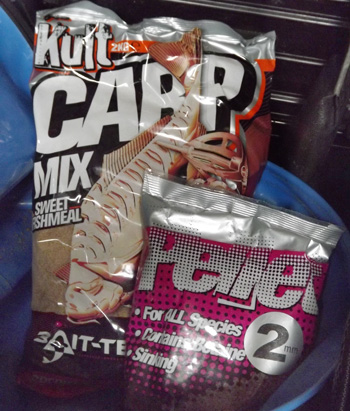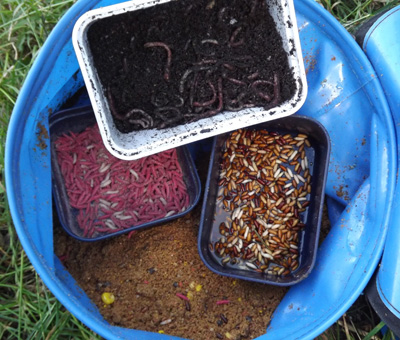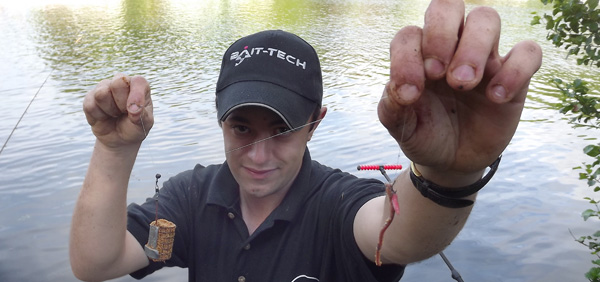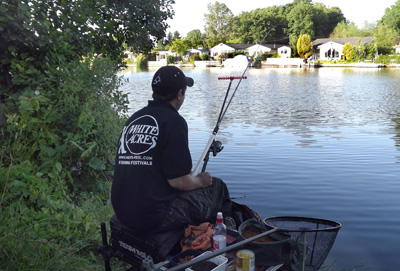I doubt there are many anglers out there who don’t enjoy fishing on rivers and I’m no exception. When I’m not competing in matches on commercial venues I often head to my local river for some sport and I particularly enjoy targeting bream using feeder tactics. Unfortunately the last couple of years have seen poor fishing due to low river levels and a distinct lack of flow, making things extremely difficult, this year however we’ve had rather a lot of rain, and the rivers are back with a bang!
Since the start of the season there have been many good catches of fish from rivers all over the country and after hearing of a few good catches from my local stretch of the River Thames I had to get down there and give it a go. For me though this is not a case of just sitting out there all day long, there are times you need to fish the river to get the most from it and I hope I can explain that to you in this article and, hopefully, help you to put a few more fish on the bank from your local river.
The Thames in south west London is a typical stretch of the lower river, a big wide expanse of water heavily used by boats, canoeists – and sometimes anglers! This has a big bearing on the times that I will actually bother to fish there, it is often so chaotic that I feel – although the fish are used to it – that it has a detrimental effect on fishing during the day, as the fish can never really settle for any amount of time, it can also frustrate you, the angler. With this in mind I target two times of day: the afternoon until just after dark and before first light until a couple of hours after the sun has come up.
Obviously both of these times avoid nearly all of the boat traffic and they also ensure a relatively constant flow instead of the constant changes due to locks opening and closing. The fish also seem to enjoy these times, they feed freely and can often be seen before it gets really bright rolling all over the river – an incredible sight and a real insight into what the place actually contains!
 For my session I decided to arrive at the River at 5pm, giving enough time to get everything sorted as the boat traffic died down. The first thing to do was to get the groundbait sorted out, I planned to fish steadily with the feeder for the afternoon – by this I mean not filling it in with loads of bait – but I would prepare bait for when I left, in readiness for the following morning.
For my session I decided to arrive at the River at 5pm, giving enough time to get everything sorted as the boat traffic died down. The first thing to do was to get the groundbait sorted out, I planned to fish steadily with the feeder for the afternoon – by this I mean not filling it in with loads of bait – but I would prepare bait for when I left, in readiness for the following morning.
My groundbait mix was very simple, 6kg of Bait-Tech Kult Sweet Fishmeal, an awesome mix which bream really like; mixing large quantities of groundbait like this by hand is hard work so now I always use a cordless drill and a whisk, which makes light work of it! Other baits I took with me were your typical bream baits really: maggots, casters and worms. I also had some boilies and pellets with me to try just in case.
Tackle for this style of fishing is far from complicated but you do need to have gear that’s up for the job, especially if there is a lot of flow where you could be casting heavy feeders to the middle of a big river, add to this that the fish can be big and swims are often full of snags you can appreciate the need for adequate gear.
The kit I use is a 12ft feeder rod, fitted with a 2oz carbon tip, carbon tips are best for rivers as their a lot stiffer than the glass ones that are so good for still waters and commercial carping. A good strong reel is also an essential piece of kit for this; cranking in big feeders on a small reel isn’t ideal and you’ll find yourself pumping it in rather than a straight retrieve which is far more efficient, my number one choice is the MAP 4000FD loaded with 8lb main line.
 The feeders you use are also very important, particularly the weight of them. Cage feeders are my first choice if the river isn’t really pushing through, otherwise I’d use a standard feeder taped up to ensure everything gets down to the bottom, the river here is around 12ft deep so the bait could end up anywhere in these conditions. The feeder I selected today is a large 25g cage feeder with an extra 10g of lead added to it at the base of the feeder, which also makes it weight forward which aids casting. The weighting needs to be perfectly balanced and takes some getting right there is a fine balance between holding bottom and being absolutely anchored which I feel is extremely important and definitely gets you a few more bites from wary fish, which may reject the bait if they felt too much weight on picking up the bait.
The feeders you use are also very important, particularly the weight of them. Cage feeders are my first choice if the river isn’t really pushing through, otherwise I’d use a standard feeder taped up to ensure everything gets down to the bottom, the river here is around 12ft deep so the bait could end up anywhere in these conditions. The feeder I selected today is a large 25g cage feeder with an extra 10g of lead added to it at the base of the feeder, which also makes it weight forward which aids casting. The weighting needs to be perfectly balanced and takes some getting right there is a fine balance between holding bottom and being absolutely anchored which I feel is extremely important and definitely gets you a few more bites from wary fish, which may reject the bait if they felt too much weight on picking up the bait.
The length of your hook length is also vital, I always start off on a two foot hook length and I feel this is a good happy medium and is a great starting point, however if you fail to catch it’s worth going up to lengths of up to 4ft, if bites are coming thick and fast, the fish are clearly coming to the feeder so shortening things up to a foot will be an excellent way of increasing your bite time. As with all kinds of fishing those who think will definitely get the most from it! My hook choice for this style is also an easy one, a size 14 Kamasan B560; these hooks are my number one choice when fishing the feeder for bream.

Starting my session off was a simple case of casting every five minutes; at this time of the afternoon the boats are at their busiest so to be honest I wasn’t too bothered about fishing but decided to have an hour to get a bit of bait in anyway. After a while though it became too much so I decided to sit and wait for things to quieten down. At around 7pm things had become far calmer and the excitement of a bite was too much to ignore!
 I started on a maggot hook bait just to see what was around, although I didn’t expect much until much later. I didn’t actually have a bite on the maggots but a change to worm bought me my first bite, a small tap followed by a pull on the tip which was met with the typical nod-nod of a bream, result! A nice bream of around 4lb was put into the net, a brilliant start and taken on the fifth cast and with this I started to introduce some casters to the feeder each cast, in an attempt to hold the fish in the swim for longer.
I started on a maggot hook bait just to see what was around, although I didn’t expect much until much later. I didn’t actually have a bite on the maggots but a change to worm bought me my first bite, a small tap followed by a pull on the tip which was met with the typical nod-nod of a bream, result! A nice bream of around 4lb was put into the net, a brilliant start and taken on the fifth cast and with this I started to introduce some casters to the feeder each cast, in an attempt to hold the fish in the swim for longer.
As it got later more bites started to materialise and to be honest I was surprised at the quality of the sport given that it was still early. The number one bait on the hook by a mile was the classic worm and maggot combo and by the end of my evening session I had amassed around 40lb of bream to 5lb, not bad for four hours of fishing.
I fed the swim heavily planning to return the next morning in the hope of having a real short bagging session! Pre-Baiting is definitely an awesome tactic for having a real big catch of bream from rivers; the fish are going up and down these stretches looking for food all the time and if they find a large enough patch of bait – or regular amounts of bait – chances are they’ll stop and take up camp there, ready and waiting for you!
As I was leaving the river at around 10pm I wouldn’t have to put a ridiculous amount of feed in as it’d be only a few hours before my return. With this in mind I had 6kg of Kult Sweet ready to go in via a catapult, to this I added a kilo of 2mm pellets, a pint of casters, two tins of corn and a kilo of 4mm Bait-Tech Marine Halibut pellets. Halibut pellets are an excellent feed for pre-baiting as they take ages to break down on the bottom compared to a standard coarse pellet, ensuring they hang around longer. After this little lot went in it was time to head home and hope the fish moved in big style for the morning.
 A 3am alarm call isn’t ideal at the best of times but I was itching to get back to the swim and see if the plan had worked and by 3.30am I was set up and ready in anticipation of a good session. I shortened up the hook length to 12in and also upped the hook size, as the fish should be feeding confidently over the baited area. As I filled the feeder under the light of my head torch I must admit to being quite excited at seeing what was going to happen, as a hardened match angler I don’t often get much chance for this sort of fishing so it was a real thrill to be out on the bank in the early hours of the morning!
A 3am alarm call isn’t ideal at the best of times but I was itching to get back to the swim and see if the plan had worked and by 3.30am I was set up and ready in anticipation of a good session. I shortened up the hook length to 12in and also upped the hook size, as the fish should be feeding confidently over the baited area. As I filled the feeder under the light of my head torch I must admit to being quite excited at seeing what was going to happen, as a hardened match angler I don’t often get much chance for this sort of fishing so it was a real thrill to be out on the bank in the early hours of the morning!
The first cast went out and a solid ‘donk’ as the feeder hit the bottom. I was on the money and almost immediately I had indications on the tip and on only my second cast had a 4lb bream on two worms! For the next couple of hours the swim was alive with activity and I had some fish rolling over my bait, a sure sign that the fish were there in numbers. The amount of bites echoed this and a succession of bream to 5lb were coming steadily; the bites however weren’t as confident as I’d expected, taps followed by a small pull on the tip!
As the sun started to rise the activity in the swim began to decrease, exactly as I expected really. Half an hour passed without a sign then I had my most positive bite of the session, and the fish felt bigger, an altogether heavier fight than the others and the big solid head thumps were a sure sign of a decent fish. I caught a glimpse of it in the clear water around 8m out and it was indeed the best fish of the session so far, at around 7lb, an awesome fish.
 Thinking that would probably be it I was surprised to have another bite on the following cast, this fish also felt bigger than usual, and as it came close to the bank, gave me a real scrap – yes a bream that fought hard! This one actually took a bit of shuffling into the landing net and at over 8lb was definitely the biggest bream I’ve had from the river so far, although I’m told that there are some real dustbin lids into double figures to be had by the carpers!
Thinking that would probably be it I was surprised to have another bite on the following cast, this fish also felt bigger than usual, and as it came close to the bank, gave me a real scrap – yes a bream that fought hard! This one actually took a bit of shuffling into the landing net and at over 8lb was definitely the biggest bream I’ve had from the river so far, although I’m told that there are some real dustbin lids into double figures to be had by the carpers!
At 6.50am the first boat of the day went past and this signalled the beginning of the end of the session, fish had stopped showing and bites had ceased. I called time to the session at 7.30am and took a look at what I had caught, 16 bream for 75 to 80lb, not bad for a short session and I think if I’d stayed through the night I may have had a lot more, but I’ll keep that for another time!
All in all I felt this session highlighted the importance of fishing for bream on rivers at the right time, they are certainly a lot easier to come by if you fish late and early – or even better through the night – and this seems to be the case on a lot of rivers throughout the country.
If you’re willing to put the time and effort in there are some terrific catches to be made so get out there and fill your boots!










